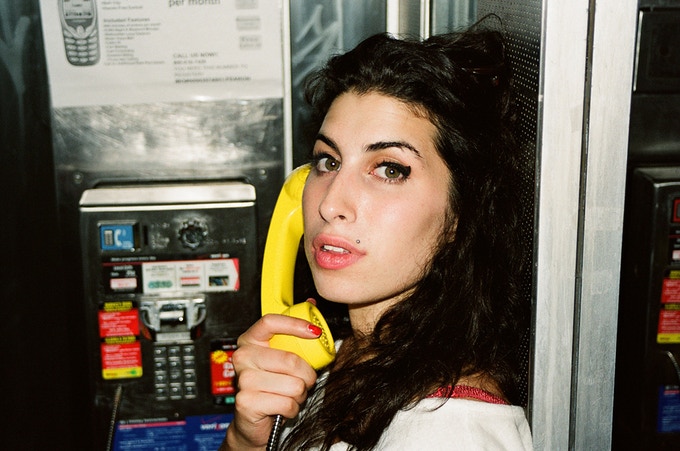‘Back to Amy’ by Charles Moriarty gives a bittersweet insight into Amy Winehouse’s early success – Review
Eight years after Amy's death, Matthew Barton delves into a photo book which captures the musical icon's debut era.
By Will Stroude

It still hurts for many of us to even think about Amy Winehouse, let alone listen to her music. I know that for me, eight years after her death, the thought of Amy is a sad one, conjuring wistful emotions about her lost potential, her youth, the way in which fame brought out the darker and more dangerous sides of her personality.
Photographer Charles Moriarty’s new book of photographs, Back to Amy, beautifully and brilliantly tempers that sadness with a real sense of profound joy, possibility, and affection. These photos were taken by Moriarty, then only 21, in the months before the release of Amy’s debut album Frank, during the summer of 2003.
They find Amy on the cusp of success; she hadn’t released a note of music, but her record company were preparing for the arrival of, as A&R director Darcus Beese attests in one of the interview transcripts contained within the book, “an artist, in the truest sense.”
What strikes one most about the photos is the palpable sense of collaboration; you get a real feel for how these images couldn’t have existed, in any way, either without Amy, or without Charles. At this time, as Moriarty describes in one of the reminiscences, Amy “didn’t like the camera too much,” but you wouldn’t know it – she appears as relaxed as she can possibly be in the photographer’s presence, and there is a definite vibe of relaxed friendship and mutual respect.
They seem to have had a symbiotic relationship; these are some of the most beautiful photos to exist of Amy Winehouse, in their stylish colour, composition, and setting, and they also seem to have brought out the best in Moriarty: the brick motif running through some of the photos, which took place both in London and New York City, brings out the earthiness and rawness of Amy’s personality juxtaposed with her garish, bright, vibrant clothing, and the mix of candid and posed shots captures the multifarious sides to Amy’s personality.
There are sultry looks to camera, offhand motion shots, shy yet sensual biting of lips, goofy gurning, and candid applying of makeup. Moriarty gets Amy’s renowned beehive on camera for the first time, more than three years before Back to Black cemented her superstar status, and it is testament to her comfort in his artistry that she affords the time to experiment.
Moriarty also incorporates classic iconography to provide further clues to the energetic personality in the shots – the vintage pink radio, the old-style launderette, a cab in a busy city street, a Dirty Dancing t-shirt, a fluorescent yellow telephone (the photo of Amy in the phone box, looking directly to camera, clutching this phone, is utterly mesmerising.)

There’s also Amy’s guitar, which she wields both as a weapon and a crutch, a prop for an exuberant and apparently extrovert yet also intrinsically shy person to hide behind. It’s an interesting dichotomy not lost on the viewer, and while Amy appears utterly confident and full of chutzpah, Moriarty captures her inherent vulnerability at the same time.
He expertly highlights the “real” Amy, and her exquisite, unusual beauty radiates from the shots. This isn’t a cookie cutter popstar, and these aren’t cookie cutter photos. They all have a real uniqueness, and seem to tell their own story. There’s the shoot where Amy has her woollen cardigan on and has her curlers in and headscarf on, looking both older than her years yet somehow girlish; there are the images from the Frank photo shoot, in her pink top and leather boots, where Amy has impromptu fun with a pair of terriers; or the roses she clutches, a symbol of romance and innocence slightly at odds with her Jewish girl about town persona.
The story told by the photos is reinforced by the interspersed essays and interview transcripts, which build up a picture of Amy as a true artist and a loyal, loving personality. There is a foreword from Asif Kapadia, the BAFTA, Grammy, and Oscar-winning director of the 2015 documentary Amy, who opines that Moriarty’s photos are “the most striking images” of Winehouse, a piece from Dazed & Confused’s Arts & Culture Editor Ashleigh Kane, an essay by critic Barney Hoskyns, a reminiscence from Amy’s mother Janis, and interviews with Darcus Beese, Winehouse band member Sam Beste, and PR manager Shane O’Neill.
They piece together both a portrait of the Amy of the time of these photos and the Amy she became over time. But while there is a sadness echoing through the book and the text, it’s never morbid or gloomy – instead, it’s a celebration and a loving homage. What recurs through the interview pieces is the memory of Amy as a wilful, funny, special person with an incredible talent and inherent musicality. They perfectly complement Moriarty’s photos, which show, just as he hoped, the “bright-eyed, vivacious and intelligent girl” Amy was.
Moriarty explains in the book that it took a long time to feel ready to show these photos; this book feels like a genuine tribute to Amy the person, and as such there is an overwhelming sense of love, joy, and fond memories. It is a time capsule of two artists, of different natures, poised for success at the outset of their careers, with an all-pervading vitality.
It may be sad looking at these photos in the knowledge of what became of Amy, but ultimately they are a lasting tribute to a remarkable person. These timeless photos are elegant and beautiful, and Back to Amy is a book to treasure.
Back to Amy: An intimate portrait of the real Amy Winehouse featuring rare and unseen photographs by Charles Moriarty published by Cassell Illustrated is available now.
